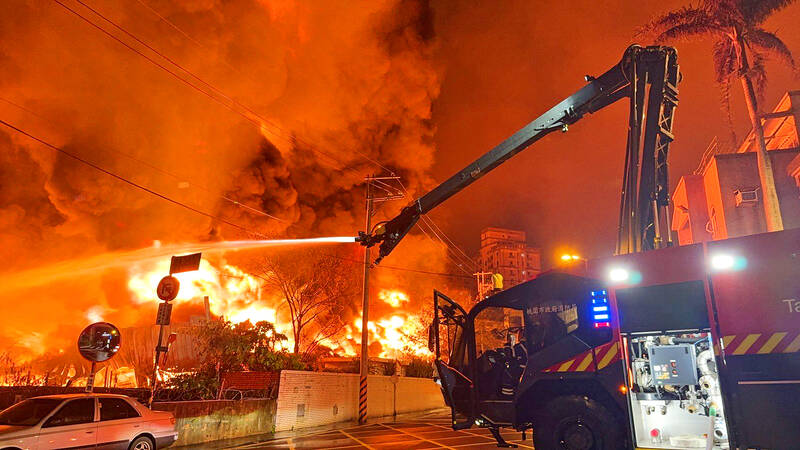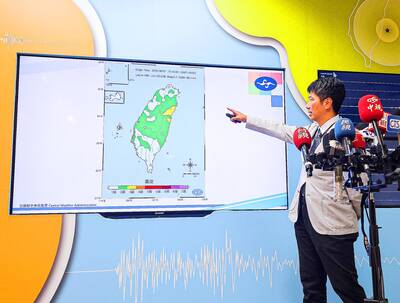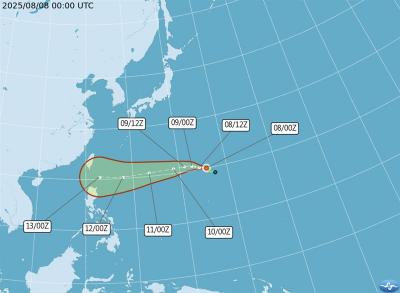The Executive Yuan yesterday unveiled a NT$26 billion (US$804 million) policy package to bolster firefighter occupational safety that centered on proposed amendments to the Fire Services Act (消防法) and subsidies to obtain equipment and technology.
Executive Yuan spokesman Chen Shih-kai (陳世凱) detailed the policies at a news conference after the day’s Cabinet meeting.
The amendments would focus on stricter rules for private enterprises to comply with fire safety codes and raising occupational safety and health standards in fire departments, he said.

Photo courtesy of the Taoyuan Fire Department
The proposed changes follow calls for reform from groups following an explosion at a factory in Pingtung County that killed four firefighters in September last year.
The plan drafted by the Ministry of the Interior also proposes to increase the firefighter training program’s capacity to 1,300 cadets, Chen said.
Fire service equipment would be modernized with the addition of new equipment before the end of next year, Chen said.
These include 88 thermal imaging drones, 88 search-and-rescue robots, 346 vehicles to replace old ones and 50,000 sets of personal protective equipment, he said.
They also include a fleet of 181 protected vehicles for responding to chemical, biological or nuclear incidents, and other specialized equipment for that purpose, Chen said.
National Fire Agency officials said the package’s funding includes NT$8.3 billion from the central government’s discretionary funds, NT$12.5 from the general budget and NT$5.3 billion from local governments.
The burden on city and county governments would be distributed according to their financial means, they said.
A preview of the draft amendments showed that owners of a facility or venue would be responsible for alerting firefighters about hazardous material stored on-site, including special procedures required for handling these substances.
The person responsible for these sites must ensure documentation and an expert on hazardous materials can be produced at any time, the amendments said.
Failure to comply with the obligation would result in a fine of up to NT$10 million.
Businessowners whose failure to maintain fire safety in their facility resulting in death could face up to seven years in prison.
The proposed changes also include rules for rewarding whistle-blowers and stiffer penalties for breaching fire codes, with commercial entities being subject to fines of up to NT$30,000.
The draft bill would also create government organizations to protect firefighter health and safety, including a national advisory committee, a National Fire Agency-led task force and units embedded in local governments.
Fire departments and bureaus must comply with government standards on firefighting equipment or face a fine of between NT$30,000 and NT$300,000.

Aftershocks from a magnitude 6.2 earthquake that struck off Yilan County at 3:45pm yesterday could reach a magnitude of 5 to 5.5, the Central Weather Administration (CWA) said. Seismological Center technical officer Chiu Chun-ta (邱俊達) told a news conference that the epicenter of the temblor was more than 100km from Taiwan. Although predicted to measure between magnitude 5 and 5.5, the aftershocks would reach an intensity of 1 on Taiwan’s 7-tier scale, which gauges the actual effect of an earthquake, he said. The earthquake lasted longer in Taipei because the city is in a basin, he said. The quake’s epicenter was about 128.9km east-southeast

GENSLER SURVEY: ‘Economic infrastructure is not enough. A city needs to inspire pride, offer moments of joy and foster a sense of belonging,’ the company said Taipei was named the city with the “highest staying power” in the world by US-based design and architecture firm Gensler. The Taiwanese capital earned the top spot among 65 cities across six continents with 64 percent of Taipei respondents in a survey of 33,000 people saying they wanted to stay in the city. Rounding out the top five were Vietnam’s Ho Chi Minh City (61 percent), Singapore (59 percent), Sydney (58 percent) and Berlin (51 percent). Sixth to 10th place went to Monterrey, Mexico; Munich, Germany; Sao Paulo, Brazil; Vancouver; and Seoul. Cities in the US were ranked separately, with Minneapolis first at

The New Taipei City Government today warned about the often-overlooked dangers of playing in water, and recommended safe swimming destinations to cool off from the summer heat. The following locations in the city as safe and fun for those looking to enjoy the water: Chienshuiwan (淺水灣), Baishawan (白沙灣), Jhongjiao Bay (中角灣), Fulong Beach Resort (福隆海水浴場) and Sansia District’s (三峽) Dabao River (大豹溪), New Taipei City Tourism and Travel Department Director-General Yang Tsung-min (楊宗珉) said. Outdoor bodies of water have variables outside of human control, such as changing currents, differing elevations and environmental hazards, all of which can lead to accidents, Yang said. Sudden

Tropical Storm Podul has formed over waters north-northeast of Guam and is expected to approach the seas southeast of Taiwan next week, the Central Weather Administration (CWA) said today. The 11th Pacific storm of the year developed at 2am over waters about 2,660km east of Oluanpi (歐鑾鼻), Pingtung County — Taiwan's southernmost tip. It is projected to move westward and could have its most significant impact on Taiwan on Wednesday and Thursday next week, the CWA said. The agency did not rule out the possibility of issuing a sea warning at that time. According to the CWA's latest update, Podul is drifting west-northwest